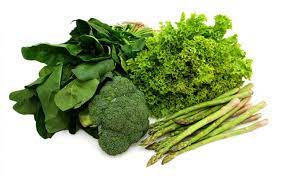11 Leafy Vegetables for over 30 people – We all know that leafy green vegetables are good for us. But did you know that there are some leafy vegetables that are especially good for people over the age of 30? Well, that’s what this article is about, read on!
Table of Contents
Kale
Kale is a leafy vegetable that is a must add to your diet, especially if you are over 30. Kale is loaded with vitamins and minerals that are essential for good health. Vitamin A, for example, is important for vision, skin and immune function. Vitamin C is important for wound healing, and kale also contains calcium, iron and folic acid.
Kale is a versatile vegetable that can be eaten raw in salads or cooked in a variety of dishes. When buying kale, look for leaves that are dark green in color and free from bruising. Kale can be stored in the refrigerator for up to five days.
To prepare kale, wash the leaves thoroughly under cold running water. Remove the tough stems and ribs from the leaves and then slice or chop the kale as desired. Kale can be steamed, sauteed or stir-fried. It can also be added to soups or stews.
Spinach
If you are over the age of 30, it is even more important to make sure that leafy vegetables are a regular part of your diet. That’s because as we age, our bodies become less efficient at absorbing nutrients from food. Leafy greens are an excellent source of vitamins A, C, and K, as well as magnesium, potassium, and calcium.
Spinach is one of the most nutrient-dense leafy greens you can eat. Just one cup of cooked spinach provides over 25% of the daily recommended intake for vitamins A and K. It is also a good source of magnesium, manganese, iron, and folate. Spinach has been shown to reduce inflammation and oxidative stress, both of which are associated with aging.
Swiss Chard
Swiss chard is a leafy vegetable that is a must add to your diet, especially if you are over the age of 30. Swiss chard is an excellent source of vitamins A, C, and K, as well as a good source of magnesium, potassium, and iron. Swiss chard also contains phytonutrients that have been shown to protect against certain types of cancer.
Collard Greens
Collard greens are one of the leafy vegetables that are a must add to your diet, especially if you are over 30. They are an excellent source of vitamins A, C, and K, and also contain fiber, calcium, and iron. Collard greens can be eaten cooked or raw, and are a great addition to salads, soups, and stews.
Broccoli Rabe
Broccoli Rabe ( Brassica oleracea italica) is a leafy vegetable that is a must-add to your diet, especially if you are over 30. Broccoli Rabe is rich in nutrients, including vitamins A, C, and K, as well as calcium and fiber. Broccoli Rabe also contains phytochemicals that have been shown to have anti-inflammatory and anticancer properties. Including broccoli rabe in your diet is an excellent way to improve your overall health and reduce your risk of chronic disease.
Mustard Greens
Mustard greens are a nutritional powerhouse, an excellent source of vitamins A, C, and K, and a good source of calcium, potassium, and fiber. Mustard greens are also low in calories and fat.
Mustard greens can be enjoyed cooked or raw. When cooking mustard greens, use only a small amount of water to prevent them from becoming mushy. Mustard greens can be used in soups, stews, stir-fries, or simply steamed. Add them to your favorite dishes for a nutritional boost.
Turnip Greens
Turnip greens are a great option to consider by people over the age of 30. These greens are high in vitamins A, C, and K, as well as calcium and iron. They also contain antioxidants and phytochemicals that can help to protect against chronic diseases.
Watercress
Watercress is high in vitamins C and K, and also contains calcium, iron, and folate. All of these nutrients are important for maintaining bone health, preventing cognitive decline, and reducing the risk of developing certain cancers.
Thyme
Thyme is a leafy green vegetable that should be included in everyone’s diet, especially those over the age of 30. This delicious vegetable is high in vitamins A and C and a good source of fiber. Thyme also contains lutein and zeaxanthin, both of which are important nutrients for eye health. So, if you’re looking for a nutritious vegetable to add to your diet, try thyme!
Basil leaves
Basil leaves should be included in your diet, especially if you are over 30. They are high in vitamins A and K, as well as magnesium, iron, and calcium. Basil leaves can be eaten raw or cooked and are an excellent addition to any dish.
Brokali Apollo
This nutrient-dense vegetable is an excellent addition to any diet, but it is especially beneficial to those over the age of 30. This is because broccoli/brokali Apollo is high in vitamins A, C, and K, as well as calcium and iron. These nutrients will not only help to keep your bones and muscles healthy as you get older, but they will also help to improve your overall health.
How to add leafy vegetables to your diet
There are a few things to consider if you want to incorporate more leafy vegetables into your diet. For starters, leafy vegetables are high in vitamins and minerals. They are also low in calories and fat, making them ideal for any diet. Furthermore, leafy vegetables are high in fiber, which aids digestion and weight loss. Finally, leafy vegetables are an excellent way to diversify your diet.
When incorporating leafy vegetables into your diet, keep in mind that they must be cooked properly in order to retain their nutrients. Steamed, sautéed, or stir-fried leafy greens should be thoroughly washed before cooking. Cooking the greens too long can cause them to lose their nutritional value. Begin by adding a small amount of leafy greens to your diet and gradually increase as your body adjusts.
How to cook leafy vegetables
To add more leafy greens to your diet, here are a few simple tips on how to get the most out of your leafy greens:
-Wash them thoroughly before cooking, as they can often be quite sandy.
-Cut them into bite-sized pieces so they’ll cook evenly.
-If you’re sautéing or stir-frying, add the greens towards the end of cooking so they don’t overcook and turn mushy.
-Add some acidity – a squeeze of lemon juice or a splash of vinegar – to brighten up the flavors.
-Don’t be afraid to experiment with different seasoning – try out different herbs and spices to find what you like best. Back To Healthtips


:max_bytes(150000):strip_icc()/greens-f0499a942c2b48078200a0a1b0ec0f6c.jpg)







